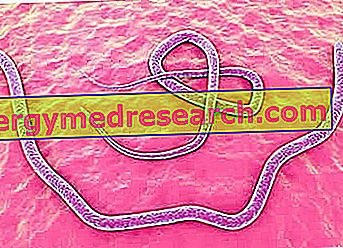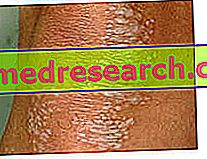Generality
Shigella is a genus of rod-like, non-motile, gram-negative, asporigenic, aerobic-optional bacteria with low resistance to heat and environmental stress.

Like salmonella and escherichie, shigellas belong to the enterobacteriaceae family; so it is not surprising that these microorganisms have their ideal habitat in the human intestine and in the primates.
Symptoms of infection
To learn more: Symptoms Shigellosis
Once in the intestine, few Shigella cells (10-100) can cause an intestinal pathology known as shigellosis or bacillary dysentery, characterized by diarrhea, abdominal cramps, intense dehydration and anorectal tenesmus.
Occasionally high vomiting and fever are found, especially in children under 10 years of age, among whom there is also a greater risk of convulsions (in which case rapid medical intervention is required).
Invasion of the intestinal wall causes tissue lesions and changes in electrolytic transport. Superficial necrosis, which can produce extensive ulcerations, determines the emission of faeces mixed with mucus and blood. In mild forms the epithelial lesions of the intestine undergo complete healing, while in the more severe ones the mucosa can remain marked by fibrotic scars with stenosis and formation of multiple polyps. Dehydration, very dangerous in children, can be recognized by the absence of tears in the crying, by the dryness of the lips and skin, and by other signs such as dizziness, sunken eyes and dry diapers.
The incubation time can vary from about ten hours to a week, but generally lasts a couple of days.
In immunosuppressed individuals, shigellosis can be fatal; despite this the mortality rate in industrialized countries remains extremely low. The ingestion of even a rather small number of bacteria is sufficient to cause the disease, especially in children between the ages of two and four (much more susceptible than adults). Due to poor compliance with hygiene standards and the increased risk of long-term healthy carriers, children are also an important source of infection.
Contagion
The interhuman transmission of shigella occurs mainly through fecal contamination of food and water. For example, direct contact with the faeces during a diaper change - not followed by careful hand washing - promotes the transmission of the disease from the child to the adult. Theoretically, shigellosis can also be contracted by swimming in water sources contaminated by sewage and sewage liquids. Failure to clean the hands after going to the toilet promotes the transmission of the disease in the communities, especially when it is followed by food handling. As a preventive measure, food must also be protected from dust and flies (possible vehicles of infection) and stored in the refrigerator to prevent bacterial multiplication. A significant epidemiological problem is represented by convalescents and healthy carriers, that is by that part of the population that despite having recovered from the disease continues to eliminate bacilli for months or even years.
Although it is a typically alimentary disease, shigellosis also falls into the category of venereal diseases. Especially in groups with poor socio-economic conditions and among homosexual males, it can in fact determine sexually transmitted vaginitis and proctitis.
The clinical diagnosis must be confirmed by the isolation of the shigella in the faeces. If a person is in good health, small infections can heal spontaneously without causing too many problems, especially if caused by Shigella sonnei . The symptomatology supported by this species is in fact generally modest and less severe than that determined by Shigella dissenteriae . The latter causes a fairly severe clinical picture even in young adults and is particularly dangerous, and sometimes fatal, in children and the elderly.
Care and treatment
To learn more: Drugs for the treatment of shighellosis
The therapy of shigellosis is based primarily on a generous rehydration of the fluids lost through diarrhea; in children it is indicated the use of specific solutions enriched with electrolytes such as sodium, potassium and calcium, available in pharmacies. In the impossibility, rehydration therapy can also be performed intravenously in a hospital setting. The use of antidiarrheal drugs, which can even aggravate the clinical picture, is contraindicated.
In the most serious cases it may be necessary to resort to a specific antibiotic treatment, indicated above all in the categories at greater risk of complications. The emergence of antibiotic-resistant shigella strains has led many physicians to reserve antibiotic therapy solely for the treatment of the most severe forms.



